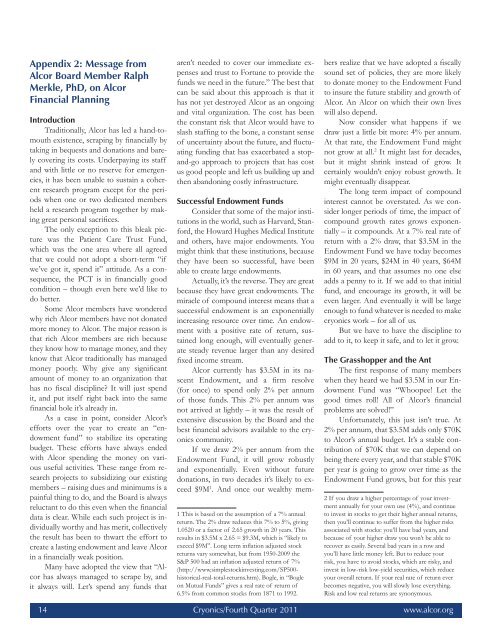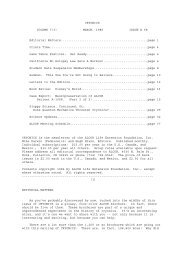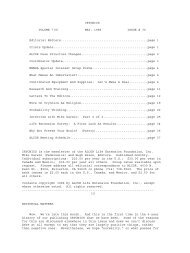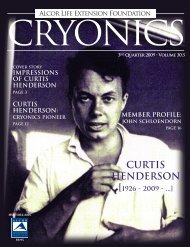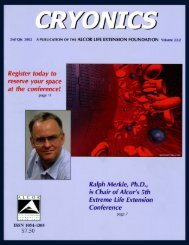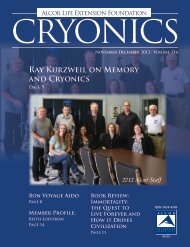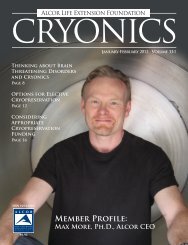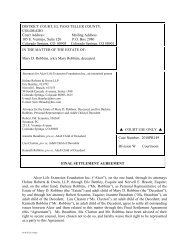Robert Ettinger - Alcor Life Extension Foundation
Robert Ettinger - Alcor Life Extension Foundation
Robert Ettinger - Alcor Life Extension Foundation
You also want an ePaper? Increase the reach of your titles
YUMPU automatically turns print PDFs into web optimized ePapers that Google loves.
Appendix 2: Message from<br />
<strong>Alcor</strong> Board Member Ralph<br />
Merkle, PhD, on <strong>Alcor</strong><br />
Financial Planning<br />
Introduction<br />
Traditionally, <strong>Alcor</strong> has led a hand-tomouth<br />
existence, scraping by financially by<br />
taking in bequests and donations and barely<br />
covering its costs. Underpaying its staff<br />
and with little or no reserve for emergencies,<br />
it has been unable to sustain a coherent<br />
research program except for the periods<br />
when one or two dedicated members<br />
held a research program together by making<br />
great personal sacrifices.<br />
The only exception to this bleak picture<br />
was the Patient Care Trust Fund,<br />
which was the one area where all agreed<br />
that we could not adopt a short-term “if<br />
we’ve got it, spend it” attitude. As a consequence,<br />
the PCT is in financially good<br />
condition – though even here we’d like to<br />
do better.<br />
Some <strong>Alcor</strong> members have wondered<br />
why rich <strong>Alcor</strong> members have not donated<br />
more money to <strong>Alcor</strong>. The major reason is<br />
that rich <strong>Alcor</strong> members are rich because<br />
they know how to manage money, and they<br />
know that <strong>Alcor</strong> traditionally has managed<br />
money poorly. Why give any significant<br />
amount of money to an organization that<br />
has no fiscal discipline? It will just spend<br />
it, and put itself right back into the same<br />
financial hole it’s already in.<br />
As a case in point, consider <strong>Alcor</strong>’s<br />
efforts over the year to create an “endowment<br />
fund” to stabilize its operating<br />
budget. These efforts have always ended<br />
with <strong>Alcor</strong> spending the money on various<br />
useful activities. These range from research<br />
projects to subsidizing our existing<br />
members – raising dues and minimums is a<br />
painful thing to do, and the Board is always<br />
reluctant to do this even when the financial<br />
data is clear. While each such project is individually<br />
worthy and has merit, collectively<br />
the result has been to thwart the effort to<br />
create a lasting endowment and leave <strong>Alcor</strong><br />
in a financially weak position.<br />
Many have adopted the view that “<strong>Alcor</strong><br />
has always managed to scrape by, and<br />
it always will. Let’s spend any funds that<br />
aren’t needed to cover our immediate expenses<br />
and trust to Fortune to provide the<br />
funds we need in the future.” The best that<br />
can be said about this approach is that it<br />
has not yet destroyed <strong>Alcor</strong> as an ongoing<br />
and vital organization. The cost has been<br />
the constant risk that <strong>Alcor</strong> would have to<br />
slash staffing to the bone, a constant sense<br />
of uncertainty about the future, and fluctuating<br />
funding that has exacerbated a stopand-go<br />
approach to projects that has cost<br />
us good people and left us building up and<br />
then abandoning costly infrastructure.<br />
Successful Endowment Funds<br />
Consider that some of the major institutions<br />
in the world, such as Harvard, Stanford,<br />
the Howard Hughes Medical Institute<br />
and others, have major endowments. You<br />
might think that these institutions, because<br />
they have been so successful, have been<br />
able to create large endowments.<br />
Actually, it’s the reverse. They are great<br />
because they have great endowments. The<br />
miracle of compound interest means that a<br />
successful endowment is an exponentially<br />
increasing resource over time. An endowment<br />
with a positive rate of return, sustained<br />
long enough, will eventually generate<br />
steady revenue larger than any desired<br />
fixed income stream.<br />
<strong>Alcor</strong> currently has $3.5M in its nascent<br />
Endowment, and a firm resolve<br />
(for once) to spend only 2% per annum<br />
of those funds. This 2% per annum was<br />
not arrived at lightly – it was the result of<br />
extensive discussion by the Board and the<br />
best financial advisors available to the cryonics<br />
community.<br />
If we draw 2% per annum from the<br />
Endowment Fund, it will grow robustly<br />
and exponentially. Even without future<br />
donations, in two decades it’s likely to exceed<br />
$9M 1 . And once our wealthy mem-<br />
1 This is based on the assumption of a 7% annual<br />
return. The 2% draw reduces this 7% to 5%, giving<br />
1.0520 or a factor of 2.65 growth in 20 years. This<br />
results in $3.5M x 2.65 = $9.3M, which is “likely to<br />
exceed $9M”. Long term inflation adjusted stock<br />
returns vary somewhat, but from 1950-2009 the<br />
S&P 500 had an inflation adjusted return of 7%<br />
(http://www.simplestockinvesting.com/SP500historical-real-total-returns.htm).<br />
Bogle, in “Bogle<br />
on Mutual Funds” gives a real rate of return of<br />
6.5% from common stocks from 1871 to 1992.<br />
bers realize that we have adopted a fiscally<br />
sound set of policies, they are more likely<br />
to donate money to the Endowment Fund<br />
to insure the future stability and growth of<br />
<strong>Alcor</strong>. An <strong>Alcor</strong> on which their own lives<br />
will also depend.<br />
Now consider what happens if we<br />
draw just a little bit more: 4% per annum.<br />
At that rate, the Endowment Fund might<br />
not grow at all. 2 It might last for decades,<br />
but it might shrink instead of grow. It<br />
certainly wouldn’t enjoy robust growth. It<br />
might eventually disappear.<br />
The long term impact of compound<br />
interest cannot be overstated. As we consider<br />
longer periods of time, the impact of<br />
compound growth rates grows exponentially<br />
– it compounds. At a 7% real rate of<br />
return with a 2% draw, that $3.5M in the<br />
Endowment Fund we have today becomes<br />
$9M in 20 years, $24M in 40 years, $64M<br />
in 60 years, and that assumes no one else<br />
adds a penny to it. If we add to that initial<br />
fund, and encourage its growth, it will be<br />
even larger. And eventually it will be large<br />
enough to fund whatever is needed to make<br />
cryonics work – for all of us.<br />
But we have to have the discipline to<br />
add to it, to keep it safe, and to let it grow.<br />
The Grasshopper and the Ant<br />
The first response of many members<br />
when they heard we had $3.5M in our Endowment<br />
Fund was “Whoopee! Let the<br />
good times roll! All of <strong>Alcor</strong>’s financial<br />
problems are solved!”<br />
Unfortunately, this just isn’t true. At<br />
2% per annum, that $3.5M adds only $70K<br />
to <strong>Alcor</strong>’s annual budget. It’s a stable contribution<br />
of $70K that we can depend on<br />
being there every year, and that stable $70K<br />
per year is going to grow over time as the<br />
Endowment Fund grows, but for this year<br />
2 If you draw a higher percentage of your investment<br />
annually for your own use (4%), and continue<br />
to invest in stocks to get their higher annual returns,<br />
then you’ll continue to suffer from the higher risks<br />
associated with stocks: you’ll have bad years, and<br />
because of your higher draw you won’t be able to<br />
recover as easily. Several bad years in a row and<br />
you’ll have little money left. But to reduce your<br />
risk, you have to avoid stocks, which are risky, and<br />
invest in low-risk low-yield securities, which reduce<br />
your overall return. If your real rate of return ever<br />
becomes negative, you will slowly lose everything.<br />
Risk and low real returns are synonymous.<br />
14 Cryonics/Fourth Quarter 2011 www.alcor.org


